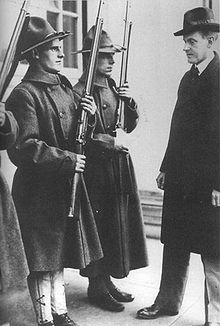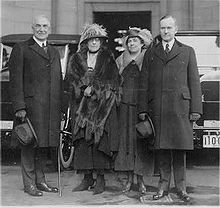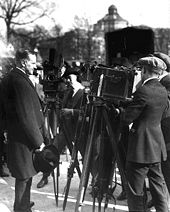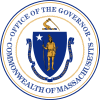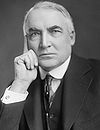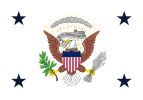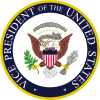- Calvin Coolidge
-
This article is about the United States president. For the ship, see SS President Coolidge.
Calvin Coolidge 
30th President of the United States In office
August 2, 1923 – March 4, 1929Vice President Charles Dawes Preceded by Warren Harding Succeeded by Herbert Hoover 29th Vice President of the United States In office
March 4, 1921 – August 2, 1923President Warren Harding Preceded by Thomas Marshall Succeeded by Charles Dawes 48th Governor of Massachusetts In office
January 2, 1919 – January 6, 1921Lieutenant Channing Cox Preceded by Samuel McCall Succeeded by Channing Cox 46th Lieutenant Governor of Massachusetts In office
January 6, 1916 – January 2, 1919Governor Samuel McCall Preceded by Grafton Cushing Succeeded by Channing Cox Personal details Born John Calvin Coolidge, Jr.
July 4, 1872
Plymouth, Vermont, U.S.Died January 5, 1933 (aged 60)
Northampton, Massachusetts, U.S.Political party Republican Spouse(s) Grace Goodhue Children John
CalvinAlma mater Amherst College Profession Lawyer Religion Congregationalism Signature 
John Calvin Coolidge, Jr. (July 4, 1872 – January 5, 1933) was the 30th President of the United States (1923–1929). A Republican lawyer from Vermont, Coolidge worked his way up the ladder of Massachusetts state politics, eventually becoming governor of that state. His conduct during the Boston Police Strike of 1919 thrust him into the national spotlight and gave him a reputation as a man of decisive action. Soon after, he was elected as the 29th Vice President in 1920 and succeeded to the Presidency upon the sudden death of Warren G. Harding in 1923. Elected in his own right in 1924, he gained a reputation as a small-government conservative, and also as a man who said very little.
Coolidge restored public confidence in the White House after the scandals of his predecessor's administration, and left office with considerable popularity.[1] As a Coolidge biographer put it, "He embodied the spirit and hopes of the middle class, could interpret their longings and express their opinions. That he did represent the genius of the average is the most convincing proof of his strength."[2] Some later criticized Coolidge as part of a general criticism of laissez-faire government.[3] His reputation underwent a renaissance during the Ronald Reagan Administration,[4] but the ultimate assessment of his presidency is still divided between those who approve of his reduction of the size of government programs and those who believe the federal government should be more involved in regulating and controlling the economy.[5]
Contents
Birth and family history
John Calvin Coolidge, Jr., was born in Plymouth Notch, Windsor County, Vermont, on July 4, 1872, the only U.S. President to be born on Independence Day. He was the elder of the two children of John Calvin Coolidge, Sr. (1845–1926) and Victoria Josephine Moor (1846–1885). Coolidge senior engaged in many occupations, and ultimately enjoyed a statewide reputation as a prosperous farmer, storekeeper and public servant; he farmed, taught school, ran a local store, served in the Vermont House of Representatives and the Vermont Senate, and held various local offices including justice of the peace and tax collector.[6] Coolidge's mother was the daughter of a Plymouth Notch farmer.[7] Coolidge's chronically ill mother died, perhaps from tuberculosis, when he was twelve years old. His sister, Abigail Grace Coolidge (1875–1890), died at the age of fifteen, when Coolidge was eighteen. Coolidge's father remarried in 1891, to a schoolteacher, and lived to the age of eighty.
Coolidge's family had deep roots in New England. His earliest American ancestor, John Coolidge, emigrated from Cottenham, Cambridgeshire, England, around 1630 and settled in Watertown, Massachusetts.[8] Another ancestor, Edmund Rice, arrived at Watertown in 1638.[9] Coolidge's great-great-grandfather, also named John Coolidge, was an American military officer in the Revolutionary War and one of the first selectmen of the town of Plymouth Notch.[10] Most of Coolidge's ancestors were farmers. Other well-known Coolidges, architect Charles Allerton Coolidge, General Charles Austin Coolidge, and diplomat Archibald Cary Coolidge among them, were descended from branches of the family that had remained in Massachusetts.[8] Coolidge's grandmother Sarah Almeda Brewer had two famous first cousins: Arthur Brown, a United States Senator, and Olympia Brown, a women's suffragist. It is through Sarah Brewer that Coolidge believed that he inherited American Indian blood, but this descent has never been established by modern genealogists.[11]
Early career and marriage
Western Massachusetts lawyer
Coolidge attended Black River Academy and then Amherst College, where he joined the Phi Gamma Delta fraternity.[12] At his father's urging, Coolidge moved to Northampton, Massachusetts, after graduating to take up the practice of law. Avoiding the costly alternative of attending a law school, Coolidge followed the more common practice of the time, apprenticing with a local law firm, Hammond & Field, and reading law with them. John C. Hammond and Henry P. Field, both Amherst graduates, introduced Coolidge to the law practice in the county seat of Hampshire County. In 1897, Coolidge was admitted to the bar, becoming a country lawyer. With his savings and a small inheritance from his grandfather, Coolidge was able to open his own law office in Northampton in 1898. He practiced transactional law, believing that he served his clients best by staying out of court. As his reputation as a hard-working and diligent attorney grew, local banks and other businesses began to retain his services.[13]
Marriage and family
In 1905, Coolidge met and married a fellow Vermonter, Grace Anna Goodhue, who was working as a teacher at the Clarke School for the Deaf. While Grace was watering flowers outside the school one day in 1903, she happened to look up at the open window of Robert N. Weir's boardinghouse and caught a glimpse of Calvin Coolidge shaving in front of a mirror with nothing on but long underwear and a hat.[14] After a more formal introduction sometime later, the two were quickly attracted to each other.[14] They were married on October 4, 1905, in the parlor of her parents' home in Burlington, Vermont.
They were opposites in personality: she was talkative and fun-loving, while he was quiet and serious.[15] Not long after their marriage, Coolidge handed her a bag with fifty-two pairs of socks in it, all of them full of holes. Grace's reply was "Did you marry me to darn your socks?" Without cracking a smile and with his usual seriousness, Calvin answered, "No, but I find it mighty handy."[16] They had two sons: John, born in 1906, and Calvin, Jr., born in 1908.[17] The marriage was, by most accounts, a happy one.[18] As Coolidge wrote in his Autobiography, "We thought we were made for each other. For almost a quarter of a century she has borne with my infirmities, and I have rejoiced in her graces."[19]
Local political office
City offices
The Republican Party was dominant in New England in Coolidge's time, and he followed Hammond's and Field's example by becoming active in local politics.[20] Coolidge campaigned locally for Republican presidential candidate William McKinley in 1896, and the next year he was selected to be a member of the Republican City Committee.[21] In 1898, he won election to the City Council of Northampton, placing second in a ward where the top three candidates were elected.[21] The position offered no salary, but gave Coolidge experience in the political world.[22] In 1899, he declined renomination, running instead for City Solicitor, a position elected by the City Council. He was elected for a one-year term in 1900, and reelected in 1901.[23] This position gave Coolidge more experience as a lawyer, and paid a salary of $600.[23] In 1902, the city council selected a Democrat for city solicitor, and Coolidge returned to an exclusively private practice.[24] Soon thereafter, however, the clerk of courts for the county died, and Coolidge was chosen to replace him. The position paid well, but barred him from practicing law, so he only remained at the job for one year.[24] The next year, 1904, Coolidge met with his only defeat before the voters, losing an election to the Northampton school board. When told that some of his neighbors voted against him because he had no children in the schools he would govern, Coolidge replied "Might give me time!"[24]
State legislator and mayor
In 1906 the local Republican committee nominated Coolidge for election to the state House of Representatives. He won a close victory over the incumbent Democrat, and reported to Boston for the 1907 session of the Massachusetts General Court.[25] In his freshman term, Coolidge served on minor committees and, although he usually voted with the party, was known as a Progressive Republican, voting in favor of such measures as women's suffrage and the direct election of Senators.[26] Throughout his time in Boston, Coolidge found himself allied primarily with the western Winthrop Murray Crane faction of the state Republican Party, as against the Henry Cabot Lodge-dominated eastern faction.[27] In 1907, he was elected to a second term. In the 1908 session, Coolidge was more outspoken, but was still not one of the leaders in the legislature.[28]
Instead of vying for another term in the State House, Coolidge returned home to his growing family and ran for mayor of Northampton when the incumbent Democrat retired. He was well liked in the town, and defeated his challenger by a vote of 1,597 to 1,409.[29] During his first term (1910 to 1911), he increased teachers' salaries and retired some of the city's debt while still managing to effect a slight tax decrease.[30] He was renominated in 1911, and defeated the same opponent by a slightly larger margin.[31]
In 1911, the State Senator for the Hampshire County area retired and encouraged Coolidge to run for his seat for the 1912 session. He defeated his Democratic opponent by a large margin.[32] At the start of that term, Coolidge was selected to be chairman of a committee to arbitrate the "Bread and Roses" strike by the workers of the American Woolen Company in Lawrence, Massachusetts.[33] After two tense months, the company agreed to the workers' demands in a settlement the committee proposed.[34] The other major issue for Republicans that year was the party split between the progressive wing, which favored Theodore Roosevelt, and the conservative wing, which favored William Howard Taft. Although he favored some progressive measures, Coolidge refused to leave the Republican party.[35] When the new Progressive Party declined to run a candidate in his state senate district, Coolidge won reelection against his Democratic opponent by an increased margin.[35]
The 1913 session was less eventful, and Coolidge's time was mostly spent on the railroad committee, of which he was the chairman.[36] Coolidge intended to retire after the 1913 session, as two terms were the norm, but when the President of the State Senate, Levi H. Greenwood, considered running for Lieutenant Governor, Coolidge decided to run again for the Senate in the hopes of being elected as its presiding officer.[37] Although Greenwood later decided to run for reelection to the Senate, he was defeated and Coolidge was elected, with Crane's help, as the President of a closely divided Senate.[38] After his election in January 1914, Coolidge delivered a speech entitled Have Faith in Massachusetts, which summarized his philosophy of government. It was later published in a book, and frequently quoted.[39]
Do the day's work. If it be to protect the rights of the weak, whoever objects, do it. If it be to help a powerful corporation better to serve the people, whatever the opposition, do that. Expect to be called a stand-patter, but don't be a stand-patter. Expect to be called a demagogue, but don't be a demagogue. Don't hesitate to be as revolutionary as science. Don't hesitate to be as reactionary as the multiplication table. Don't expect to build up the weak by pulling down the strong. Don't hurry to legislate. Give administration a chance to catch up with legislation. Have Faith in Massachusetts as delivered by Calvin Coolidge to the Massachusetts State Senate, 1914.[40] Coolidge's speech was well-received and he attracted some admirers on its account.[41] Towards the end of the term, many of them were proposing his name for nomination to lieutenant governor. After winning reelection to the Senate by an increased margin in the 1914 elections, Coolidge was reelected unanimously to be President of the Senate.[42] As the 1915 session ended, Coolidge's supporters, led by fellow Amherst alumnus Frank Stearns, encouraged him again to run for lieutenant governor. This time, he accepted their advice.[43]
Lieutenant Governor
Coolidge entered the primary election for lieutenant governor and was nominated to run alongside gubernatorial candidate Samuel W. McCall. Coolidge was the leading vote-getter in the Republican primary, and balanced the Republican ticket by adding a western presence to McCall's eastern base of support.[44] McCall and Coolidge won the 1915 election, with Coolidge defeating his opponent by more than 50,000 votes.[45]
Coolidge's duties as lieutenant governor were few; in Massachusetts, the lieutenant governor does not preside over the state Senate, although Coolidge did become an ex officio member of the governor's cabinet.[46] As a full-time elected official, Coolidge no longer practiced law after 1916, though his family continued to live in Northampton.[47] McCall and Coolidge were both reelected in 1916 and again in 1917 (At the time, both offices were held for one-year terms). When McCall decided that he would not stand for a fourth term, Coolidge announced his intention to run for governor.[48]
Governor of Massachusetts
1918 election
Coolidge was unopposed for the Republican nomination for Governor of Massachusetts in 1918. He and his running mate, Channing Cox, a Boston lawyer and Speaker of the Massachusetts House of Representatives, ran on the previous administration's record: fiscal conservatism, a vague opposition to Prohibition, support for women's suffrage, and support for American involvement in World War I.[49] The issue of the war proved divisive, especially among Irish- and German-Americans.[50] Coolidge was elected by a margin of 16,773 votes over his opponent, Richard H. Long, in the smallest margin of victory of any of his state-wide campaigns.[51]
Boston police strike
Main article: Boston Police StrikeIn 1919, in response to rumors that policemen of the Boston Police Department planned to form a union, Police Commissioner Edwin U. Curtis issued a statement saying that such a move would not be tolerated. In August of that year, the American Federation of Labor issued a charter to the Boston Police Union.[52] Curtis said the union's leaders were insubordinate and planned to relieve them of duty, but said that he would suspend the sentence if the union was dissolved by September 4.[53] The mayor of Boston, Andrew Peters, convinced Curtis to delay his action for a few days, but Curtis ultimately suspended the union leaders on September 8.[54]
"Your assertion that the Commissioner was wrong cannot justify the wrong of leaving the city unguarded. That furnished the opportunity; the criminal element furnished the action. There is no right to strike against the public safety by anyone, anywhere, any time. ... I am equally determined to defend the sovereignty of Massachusetts and to maintain the authority and jurisdiction over her public officers where it has been placed by the Constitution and laws of her people." (emphasis added) Telegram from Governor Calvin Coolidge to Samuel Gompers September 14, 1919.[55] The following day, about three-quarters of the policemen in Boston went on strike.[56] Coolidge had observed the situation throughout the conflict, but had not yet intervened. That night and the next, there was sporadic violence and rioting in the lawless city.[57] Peters, concerned about sympathy strikes, had called up some units of the Massachusetts National Guard stationed in the Boston area and relieved Curtis of duty.[58] Coolidge, furious that the mayor had called out state guard units, finally acted.[59] He called up more units of the National Guard, restored Curtis to office, and took personal control of the police force.[60] Curtis proclaimed that all of the strikers were fired from their jobs, and Coolidge called for a new police force to be recruited.[61]
That night Coolidge received a telegram from AFL leader Samuel Gompers. "Whatever disorder has occurred", Gompers wrote, "is due to Curtis's order in which the right of the policemen has been denied …"[62] Coolidge publicly answered Gompers's telegram with the response that would launch him into the national consciousness (quoted, above left).[62] Newspapers across the nation picked up on Coolidge's statement and he became the newest hero to opponents of the strike. In the midst of the First Red Scare, many Americans were terrified of the spread of communist revolution, like those that had taken place in Russia, Hungary, and Germany. While Coolidge had lost some friends among organized labor, conservatives across the nation had seen a rising star. Although he usually acted with deliberation, the Boston police strike gave him a national reputation as a man who would take decisive action.
1919 election
Coolidge and Cox were renominated for their respective offices in 1919. By this time Coolidge's supporters (especially Stearns) had publicized his actions in the Police Strike around the state and the nation and some of Coolidge's speeches were published in book form.[39] He faced the same opponent as in 1918, Richard Long, but this time Coolidge defeated him by 125,101 votes, more than seven times his margin of victory from a year earlier.[63] His actions in the police strike, combined with the massive electoral victory, led to suggestions that Coolidge run for President in 1920.[64]
Legislation and vetoes as governor
By the time Coolidge was inaugurated on January 2, 1919, the First World War had ended, and Coolidge pushed the legislature to give a $100 bonus to Massachusetts veterans. He also signed a bill reducing the work week for women and children from fifty-four hours to forty-eight, saying, "We must humanize the industry, or the system will break down."[65] He signed into law a budget that kept the tax rates the same, while trimming four million dollars from expenditures, thus allowing the state to retire some of its debt.[66]
Coolidge also wielded the veto pen as governor. His most publicized veto was of a bill that would have increased legislators' pay by 50%.[67] Although Coolidge was personally opposed to Prohibition, he vetoed a bill in May 1920 that would have allowed the sale of beer or wine of 2.75% alcohol or less, in Massachusetts in violation of the Eighteenth Amendment to the United States Constitution. "Opinions and instructions do not outmatch the Constitution," he said in his veto message, "Against it, they are void."[68]
Vice Presidency
1920 election
Main article: United States presidential election, 1920At the 1920 Republican National Convention most of the delegates were selected by state party conventions, not primaries. As such, the field was divided among many local favorites.[69] Coolidge was one such candidate, and while he placed as high as sixth in the voting, the powerful party bosses never considered him a serious candidate. After ten ballots, the delegates settled on Senator Warren G. Harding of Ohio as their nominee for President.[70] When the time came to select a Vice Presidential nominee, the party bosses had also made a decision on who they would nominate: Senator Irvine Lenroot of Wisconsin.[71] A delegate from Oregon, Wallace McCamant, having read Have Faith in Massachusetts, proposed Coolidge for Vice President instead.[71] The suggestion caught on quickly, and Coolidge found himself unexpectedly nominated.[72]
The Democrats nominated another Ohioan, James M. Cox, for President and the Assistant Secretary of the Navy, Franklin D. Roosevelt, for Vice President. The question of the United States joining the League of Nations was a major issue in the campaign, as was the unfinished legacy of Progressivism.[73] Harding ran a "front-porch" campaign from his home in Marion, Ohio, but Coolidge took to the campaign trail in the Upper South, New York, and New England.[74] On November 2, 1920, Harding and Coolidge were victorious in a landslide, winning every state outside the South.[75] They also won in Tennessee, the first time a Republican ticket had won a Southern state since Reconstruction.[75]
"Silent Cal"
The Vice-Presidency did not carry many official duties, but Coolidge was invited by President Harding to attend cabinet meetings, making him the first Vice President to do so.[76] He gave speeches around the country, but none were especially noteworthy.[77]
As Vice-President, Coolidge and his vivacious wife Grace were invited to quite a few parties, where the legend of "Silent Cal" was born. It is from this time that most of the jokes and anecdotes involving Coolidge originate. Although Coolidge was known to be a skilled and effective public speaker, in private he was a man of few words and was therefore commonly referred to as "Silent Cal." A possibly apocryphal story has it that Dorothy Parker, seated next to him at a dinner, said to him, "Mr. Coolidge, I've made a bet against a fellow who said it was impossible to get more than two words out of you." His famous reply: "You lose."[78] It was also Parker who, upon learning that Coolidge had died, reportedly remarked, "How can they tell?"[79] Alice Roosevelt Longworth supposedly once commented that, "He looks as if he'd been weaned on a pickle."[80] Coolidge often seemed uncomfortable among fashionable Washington society; when asked why he continued to attend so many of their dinner parties, he replied, "Got to eat somewhere."[81]
As President, Coolidge's reputation as a quiet man continued. "The words of a President have an enormous weight," he would later write, "and ought not to be used indiscriminately."[82] Coolidge was aware of his stiff reputation; indeed, he cultivated it. "I think the American people want a solemn ass as a President," he once told Ethel Barrymore, "and I think I will go along with them."[83] However, he did hold a then-record number of presidential press conferences, 520 during his presidency.[84] Some historians would later suggest that Coolidge's image was created deliberately as a campaign tactic,[85] while others believe his withdrawn and quiet behavior to be natural, deepening after the death of his son in 1924.[86]
Presidency 1923–1929
Succession to the Presidency
On August 2, 1923, President Harding died while on a speaking tour in California.[87] Vice-President Coolidge was in Vermont visiting his family home, which had neither electricity nor a telephone, when he received word by messenger of Harding's death.[88] Coolidge dressed, said a prayer, and came downstairs to greet the reporters who had assembled.[88] His father, a notary public, administered the oath of office in the family's parlor by the light of a kerosene lamp at 2:47 am on August 3, 1923; Coolidge then went back to bed. Coolidge returned to Washington the next day, and was re-sworn by Justice Adolph A. Hoehling, Jr. of the Supreme Court of the District of Columbia, as there was some confusion over whether a state notary public had the authority to administer the presidential oath.[89][90]
Finishing Harding's term
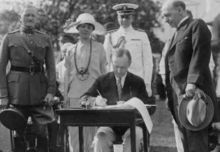 Coolidge signing the Immigration Act and some appropriation bills. General John J. Pershing looks on.
Coolidge signing the Immigration Act and some appropriation bills. General John J. Pershing looks on.
The nation did not know what to make of its new President; Coolidge had not stood out in the Harding administration and many had expected him to be replaced on the ballot in 1924.[91] He appointed C. Bascom Slemp, a Virginia Congressman and experienced federal politician[92] to work jointly with Edward T. Clark, a Massachusetts Republican organizer whom he retained from his vice presidential staff, as Secretaries to the President (a position equivalent to the modern White House Chief of Staff).[93] Although many of Harding's cabinet appointees were scandal-tarred, Coolidge announced that he would not demand any of their resignations, believing that since the people had elected Harding, he should carry on Harding's presidency, at least until the next election.[93]
He addressed Congress when it reconvened on December 6, 1923, giving a speech that echoed many of Harding's themes, including immigration restriction and the need for the government to arbitrate the coal strikes then ongoing in Pennsylvania.[94] Coolidge's speech was the first Presidential speech to be broadcast to the nation over the radio[95] The Washington Naval Treaty was proclaimed just one month into Coolidge's term, and was generally well received in the country.[93] In May 1924, the World War I veterans' World War Adjusted Compensation Act or "Bonus Bill" was passed over his veto.[96] Coolidge signed the Immigration Act later that year, though he appended a signing statement expressing his unhappiness with the bill's specific exclusion of Japanese immigrants.[97] Just before the Republican Convention began, Coolidge signed into law the Revenue Act of 1924, which decreased personal income tax rates while increasing the estate tax, and creating a gift tax to reinforce the transfer tax system.[98]
1924 election
Main article: United States presidential election, 1924The Republican Convention was held from June 10–12, 1924 in Cleveland, Ohio; President Coolidge was nominated on the first ballot.[99] The convention nominated Frank Lowden of Illinois for Vice President on the second ballot, but he declined by telegram.[100] Former Brigadier General Charles G. Dawes, who would win the Nobel Peace Prize in 1925, was nominated on the third ballot; he accepted.[100]
The Democrats held their convention from June 24 to July 9 in New York City. The convention soon deadlocked, and after 103 ballots, the delegates finally agreed on a compromise candidate, John W. Davis, with Charles W. Bryan nominated for Vice President. The Democrats' hopes were buoyed when Robert M. La Follette, Sr., a Republican Senator from Wisconsin, split from his party to form a new Progressive Party. Many believed that the split in the Republican party, like the one in 1912, would allow a Democrat to win the Presidency.[101]
Shortly after the conventions Coolidge experienced a personal tragedy. Coolidge's younger son, Calvin, Jr., developed a blister from playing tennis on the White House courts. The blister became infected, and within days Calvin, Jr. developed sepsis and died. After that Coolidge became withdrawn. He later said that "when he died, the power and glory of the Presidency went with him."[102] In spite of his sadness, Coolidge ran his conventional campaign; he never maligned his opponents (or even mentioned them by name) and delivered speeches on his theory of government, including several that were broadcast over radio.[103] It was easily the most subdued campaign since 1896, partly because the President was grieving for his son, but partly because Coolidge's style was naturally non-confrontational.[104] The other candidates campaigned in a more modern fashion, but despite the split in the Republican party, the results were very similar to those of 1920. Coolidge and Dawes won every state outside the South except for Wisconsin, La Follette's home state. Coolidge had a popular vote majority of 2.5 million over his opponents' combined total.[105]
Industry and trade
... it is probable that a press which maintains an intimate touch with the business currents of the nation is likely to be more reliable than it would be if it were a stranger to these influences. After all, the chief business of the American people is business. They are profoundly concerned with buying, selling, investing and prospering in the world. (emphasis added) President Calvin Coolidge's address to the American Society of Newspaper Editors, Washington D.C., January 25, 1925.[106] During Coolidge's presidency the United States experienced the period of rapid economic growth known as the "Roaring Twenties". He left the administration's industrial policy in the hands of his activist Secretary of Commerce, Herbert Hoover, who energetically used government auspices to promote business efficiency and develop airlines and radio.[107] With the exception of favoring increased tariffs, Coolidge disdained regulation, and carried about this belief by appointing commissioners to the Federal Trade Commission and the Interstate Commerce Commission who did little to restrict the activities of businesses under their jurisdiction.[108] The regulatory state under Coolidge was, as one biographer described it, "thin to the point of invisibility."[109]
Coolidge's economic policy has often been misquoted as "generally speaking, the business of the American people is business" (full quotation at right). Some have criticized Coolidge as an adherent of the laissez-faire ideology, which they claim led to the Great Depression.[110] On the other hand, historian Robert Sobel offers some context based on Coolidge's sense of federalism: "As Governor of Massachusetts, Coolidge supported wages and hours legislation, opposed child labor, imposed economic controls during World War I, favored safety measures in factories, and even worker representation on corporate boards. Did he support these measures while president? No, because in the 1920s, such matters were considered the responsibilities of state and local governments."[111]
Taxation
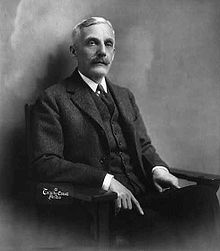 Secretary of the Treasury Andrew W. Mellon worked with Coolidge to reduce taxes while retiring government debt
Secretary of the Treasury Andrew W. Mellon worked with Coolidge to reduce taxes while retiring government debt
Coolidge's taxation policy was that of his Secretary of the Treasury, Andrew Mellon: taxes should be lower and fewer people should have to pay them.[112] Congress agreed, and the taxes were reduced in Coolidge's term.[112] In addition to these tax cuts, Coolidge proposed reductions in federal expenditures and retiring some of the federal debt.[112] Coolidge's ideas were shared by the Republicans in Congress, and in 1924 Congress passed the Revenue Act of 1924, which reduced income tax rates and eliminated all income taxation for some two million people.[112] They reduced taxes again by passing the Revenue Acts of 1926 and 1928, all the while continuing to keep spending down so as to reduce the overall federal debt.[113] By 1927, only the richest 2% of taxpayers paid any federal income tax.[113] Although federal spending remained flat during Coolidge's administration, allowing one-fourth of the federal debt to be retired, state and local governments saw considerable growth, surpassing the federal budget in 1927.[114]
Farm subsidies
Perhaps the most contentious issue of Coolidge's presidency was that of relief for farmers. Some in Congress proposed a bill designed to fight falling agricultural prices by allowing the federal government to purchase crops to sell abroad at lowered prices.[115] Agriculture Secretary Henry C. Wallace and other administration officials favored the bill when it was introduced in 1924, but rising prices convinced many in Congress that the bill was unnecessary, and it was defeated just before the elections that year.[116] In 1926, with farm prices falling once more, Senator Charles L. McNary and Representative Gilbert N. Haugen—both Republicans—proposed the McNary-Haugen Farm Relief Bill. The bill proposed a federal farm board that would purchase surplus production in high-yield years and hold it (when feasible) for later sale, or sell it abroad.[117] Coolidge opposed McNary-Haugen, declaring that agriculture must stand "on an independent business basis," and said that "government control cannot be divorced from political control."[117] He favored instead Herbert Hoover's proposal to modernize agriculture to create profits, instead of manipulating prices. Secretary Mellon wrote a letter denouncing the McNary-Haugen measure as unsound and likely to cause inflation, and it was defeated.[118]
After McNary-Haugen's defeat, Coolidge supported a less radical measure, the Curtis-Crisp Act, which would have created a federal board to lend money to farm co-operatives in times of surplus; the bill did not pass.[118] In February 1927, Congress took up the McNary-Haugen bill again, this time narrowly passing it.[119] Coolidge vetoed it.[119] In his veto message, he expressed the belief that the bill would do nothing to help farmers, benefitting only exporters and expanding the federal bureaucracy.[120] Congress did not override the veto, but passed the bill again in May 1928 by an increased majority; again, Coolidge vetoed it.[119] "Farmers never have made much money," said Coolidge, the Vermont farmer's son, "I do not believe we can do much about it."[121]
Flood control
Coolidge has often been criticized for his actions during the Great Mississippi Flood of 1927, the worst natural disaster to hit the Gulf Coast until Hurricane Katrina in 2005.[122] Although he did eventually name Secretary Hoover to a commission in charge of flood relief, Coolidge's lack of interest in federal flood control has been criticized.[122] Coolidge did not believe that personally visiting the region after the floods would accomplish anything, but would be seen only as political grandstanding. He also did not want to incur the federal spending that flood control would require; he believed property owners should bear much of the cost.[123] On the other hand, Congress wanted a bill that would place the federal government completely in charge of flood mitigation.[124] When Congress passed a compromise measure in 1928, Coolidge declined to take credit for it and signed the bill in private on May 15.[125]
Civil rights
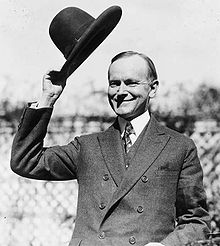 Coolidge is shown above on October 22, 1924, holding a ceremonial hat of the fictitious[126] Smoki Indians.
Coolidge is shown above on October 22, 1924, holding a ceremonial hat of the fictitious[126] Smoki Indians.
Coolidge spoke out in favor of the civil rights of African Americans and Catholics.[127] He appointed no known members of the Ku Klux Klan to office; indeed the Klan lost most of its influence during his term.[128]
In 1924, Coolidge responded to a letter that claimed the United States was a "white man's country":
....I was amazed to receive such a letter. During the war 500,000 colored men and boys were called up under the draft, not one of whom sought to evade it. [As president, I am] one who feels a responsibility for living up to the traditions and maintaining the principles of the Republican Party. Our Constitution guarantees equal rights to all our citizens, without discrimination on account of race or color. I have taken my oath to support that Constitution....[129]On June 2, 1924, Coolidge signed the Indian Citizenship Act, which granted full U.S. citizenship to all American Indians, while permitting them to retain tribal land and cultural rights. However, the act was unclear on whether the federal government or the tribal leaders retained tribal sovereignty.[130] Coolidge repeatedly called for anti-lynching laws to be enacted, but most Congressional attempts to pass this legislation were filibustered by Southern Democrats.
Coolidge appointed some African Americans to federal office. He retained Harding's choice of Walter L. Cohen of New Orleans, Louisiana, as the comptroller of customs and offered Cohen the post of minister to Liberia, which the businessman declined.[131]
Foreign policy
Although not an isolationist, Coolidge was reluctant to enter into foreign alliances.[132] Coolidge saw the landslide Republican victory of 1920 as a rejection of the Wilsonian idea that the United States should join the League of Nations.[133] While not completely opposed to the idea, Coolidge believed the League, as then constituted, did not serve American interests, and he did not advocate membership in it.[133] He spoke in favor of the United States joining the Permanent Court of International Justice, provided that the nation would not be bound by advisory decisions.[134] The Senate eventually approved joining the Court (with reservations) in 1926.[135] The League of Nations accepted the reservations, but suggested some modifications of their own.[136] The Senate failed to act; the United States never joined the World Court.[136]
Coolidge's best-known initiative was the Kellogg-Briand Pact of 1928, named for Coolidge's Secretary of State, Frank B. Kellogg, and French foreign minister Aristide Briand. The treaty, ratified in 1929, committed signatories including the U.S., the United Kingdom, France, Germany, Italy, and Japan to "renounce war, as an instrument of national policy in their relations with one another."[137] The treaty did not achieve its intended result – the outlawry of war – but did provide the founding principle for international law after World War II.[138]
Coolidge continued the previous administration's policy not to recognize the Soviet Union.[139] He also continued the United States' support for the elected government of Mexico against the rebels there, lifting the arms embargo on that country.[140] He sent his close friend Dwight Morrow to Mexico as the American ambassador.[141] Coolidge represented the U.S. at the Pan American Conference in Havana, Cuba, making him the only sitting U.S. President to visit the country. The United States' occupation of Nicaragua and Haiti continued under his administration, but Coolidge withdrew American troops from the Dominican Republic in 1924.[142]
1928 Election
Main article: United States presidential election, 1928Collection of video clips of the president
In the summer of 1927, Coolidge vacationed in the Black Hills of South Dakota, where he engaged in horseback riding and fly fishing and attended rodeos. He made Custer State Park his "summer White House". News coverage of Coolidge's time in the Black Hills soon increased tourism in the general region and promoted the popularity of Wind Cave National Park.[143] While on vacation, Coolidge surprisingly issued his terse statement that he would not seek a second full term as President in 1928: "I do not choose to run for President in 1928."[144] After allowing the reporters to take that in, Coolidge elaborated. "If I take another term, I will be in the White House till 1933 … Ten years in Washington is longer than any other man has had it—too long!"[145] In his memoirs, Coolidge explained his decision not to run: "The Presidential office takes a heavy toll of those who occupy it and those who are dear to them. While we should not refuse to spend and be spent in the service of our country, it is hazardous to attempt what we feel is beyond our strength to accomplish."[146] After leaving office, he and Grace returned to Northampton, where he wrote his memoirs. The Republicans retained the White House in 1928 in the person of Coolidge's Secretary of Commerce, Herbert Hoover.
Coolidge had been reluctant to choose Hoover as his successor; on one occasion he remarked that "for six years that man has given me unsolicited advice—all of it bad."[147] Even so, Coolidge had no desire to split the party by publicly opposing the popular Commerce Secretary's nomination.[148] The delegates did consider nominating Vice President Charles Dawes to be Hoover's running mate. But Coolidge (who hated Dawes) remarked that this would be "a personal affront" to him, and the convention selected Senator Charles Curtis instead.[149]
Cabinet
 Coolidge's cabinet in 1924, outside the White House
Coolidge's cabinet in 1924, outside the White House
Front row, left to right: Harry Stewart New, John W. Weeks, Charles Evans Hughes, Coolidge, Andrew Mellon, Harlan F. Stone, Curtis D. Wilbur
Back row, left to right, James J. Davis, Henry C. Wallace, Herbert Hoover, Hubert WorkOFFICE NAME TERM President Calvin Coolidge 1923–1929 Vice President None 1923–1925 Charles G. Dawes 1925–1929 Secretary of State Charles Evans Hughes 1923–1925 Frank B. Kellogg 1925–1929 Secretary of the Treasury Andrew Mellon 1923–1929 Secretary of War John W. Weeks 1923–1925 Dwight F. Davis 1925–1929 Attorney General Harry M. Daugherty 1923–1924 Harlan F. Stone 1924–1925 John G. Sargent 1925–1929 Postmaster General Harry S. New 1923–1929 Secretary of the Navy Edwin Denby 1923–1924 Curtis D. Wilbur 1924–1929 Secretary of the Interior Hubert Work 1923–1928 Roy O. West 1928–1929 Secretary of Agriculture Henry C. Wallace 1923–1924 Howard M. Gore 1924–1925 William M. Jardine 1925–1929 Secretary of Commerce Herbert Hoover 1923–1928 William F. Whiting 1928–1929 Secretary of Labor James J. Davis 1923–1929 Judicial appointments
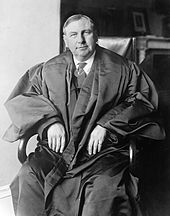 Coolidge appointed Harlan Fiske Stone Attorney General and then Supreme Court Justice
Coolidge appointed Harlan Fiske Stone Attorney General and then Supreme Court Justice
Supreme Court
Coolidge appointed one Justice to the Supreme Court of the United States, Harlan Fiske Stone in 1925. Stone was Coolidge's fellow Amherst alumnus, a Wall Street lawyer and conservative Republican. Stone was serving as dean of Columbia Law School when Coolidge appointed him to be Attorney General in 1924 to restore the reputation tarnished by Harding's Attorney General, Harry M. Daugherty. Coolidge named Stone to the Supreme Court in 1925.[150] Stone was later appointed Chief Justice by President Franklin D. Roosevelt.
Other courts
Main article: Calvin Coolidge judicial appointmentsAlong with his Supreme Court appointment, Coolidge successfully nominated 17 judges to the United States Courts of Appeals, and 61 judges to the United States district courts. He appointed judges to various specialty courts as well, including Genevieve R. Cline, who became the first woman named to the Federal judiciary when Coolidge placed her on the United States Customs Court in 1928.[151] Coolidge also signed the Judiciary Act of 1925 into law, allowing the Supreme Court more discretion over its workload.
Retirement and death
 Coolidge addressing a crowd at Arlington National Cemetery's Roman style Memorial Amphitheater in 1924.
Coolidge addressing a crowd at Arlington National Cemetery's Roman style Memorial Amphitheater in 1924.
After his presidency, Coolidge retired to his beloved Northampton home, "The Beeches," where he became a local fixture. He kept a Hacker runabout boat on the Connecticut River and was often observed on the water by local boating enthusiasts. During this period he also served as chairman of the non-partisan Railroad Commission, as honorary president of the American Foundation for the Blind, as a director of New York Life Insurance Company, as president of the American Antiquarian Society, and as a trustee of Amherst College.[152] Coolidge received an honorary Doctor of Laws from Bates College in Lewiston, Maine.
Coolidge published his autobiography in 1929 and wrote a syndicated newspaper column, "Calvin Coolidge Says," from 1930 to 1931.[153] Faced with looming defeat in 1932, some Republicans spoke of rejecting Herbert Hoover as their party's nominee, and instead drafting Coolidge to run, but the former President made it clear that he was not interested in running again, and that he would publicly repudiate any effort to draft him, should it come about.[154] Hoover was renominated, and Coolidge made several radio addresses in support of him.[155]
He died suddenly of a heart attack at "The Beeches," at 12:45 pm, January 5, 1933.[156] Shortly before his death, Coolidge confided to an old friend: "I feel I no longer fit in with these times."[157]
Coolidge is buried beneath a simple headstone in Notch Cemetery, Plymouth Notch, Vermont, where the family home is maintained as one of the original buildings on the site, all of which comprise the Calvin Coolidge Homestead District. The State of Vermont dedicated a new visitors' center nearby to mark Coolidge's 100th birthday on July 4, 1972.[158] Calvin Coolidge's "Brave Little State of Vermont speech" is memorialized in the Hall of Inscriptions at the Vermont State House in Montpelier, Vermont.
Radio, film, and commemorations
Despite his reputation as a quiet and even reclusive politician, Coolidge made use of the new medium of radio and made radio history several times while President. He made himself available to reporters, giving 529 press conferences, meeting with reporters more regularly than any President before or since.[159]
Coolidge's inauguration was the first presidential inauguration broadcast on radio. On December 6, 1923, he was the first President whose address to Congress was broadcast on radio.[160] On February 22, 1924, he became the first President of the United States to deliver a political speech on radio.[161] Coolidge signed the Radio Act of 1927, which assigned regulation of radio to the newly created Federal Radio Commission.
On August 11, 1924, Lee De Forest filmed Coolidge on the White House lawn with DeForest's Phonofilm sound-on-film process, becoming the first President to appear in a sound film. The title of the DeForest film was President Coolidge, Taken on the White House Grounds.[162]
Coolidge was the only president to have his portrait on a coin during his lifetime, the Sesquicentennial of American Independence Half Dollar, minted in 1926. After his death he also appeared on a postage stamp, pictured below.
See also
Notes
- ^ McCoy, 420–421; Greenberg, 49–53
- ^ Fuess, 500
- ^ McCoy, 418; Greenberg, 146–150; Ferrell, 66–72
- ^ Sobel, 12–13; Greenberg, 2–3
- ^ Greenberg, 1–7
- ^ Death Of Colonel John Coolidge, Time Magazine
- ^ Fuess, 17; McCoy, 5; White, 11
- ^ a b Fuess, 12
- ^ Edmund Rice (1638) Association, 2007. Descendants of Edmund Rice: The First Nine Generations. (CD-ROM)
- ^ Fuess, 7
- ^ McCoy, 5
- ^ Greenberg, 16-20
- ^ Fuess, 74–81; McCoy 22–26
- ^ a b Sobel, 55
- ^ Greenberg, 58–59
- ^ Teleen, Maurice (Autumn, 2001). "75 Years Ago Today". The Draft Horse Journal. Archived from the original on May 18, 2006. http://web.archive.org/web/20060518031030/http://www.drafthorsejournal.com/daysbeforeyesterday/autumn01/75yearsago/75yearsago.htm.
- ^ White, 65–66
- ^ Fuess, 89–92; Sobel, 57–58. Some biographers disagree with this rosy portrait, see Ferrell, 21–23
- ^ Coolidge, Calvin (1929). "Law and Politics". The Autobiography of Calvin Coolidge. Cosmopolitan Book Corp. p. 93. http://www.archive.org/stream/autobiographycal011459mbp#page/n113/mode/2up.
- ^ Sobel, 49–51
- ^ a b Sobel, 51
- ^ Fuess, 83
- ^ a b Fuess, 84–85
- ^ a b c McCoy, 29
- ^ Sobel, 61
- ^ Sobel, 62; Fuess, 99
- ^ Sobel, 63–66
- ^ Sobel, 68–69
- ^ Sobel, 72
- ^ Fuess, 106–107; Sobel, 74
- ^ Fuess, 108
- ^ Sobel, 76
- ^ See also the main article, Lawrence textile strike, for a full description.
- ^ Fuess, 110–111; McCoy, 45–46
- ^ a b Sobel, 79–80; Fuess, 111
- ^ Fuess, 111–113
- ^ Fuess, 114–115
- ^ Sobel, 80–82
- ^ a b Coolidge, Calvin (1919). "To The State Senate On Being Elected Its President". Have Faith in Massachusetts: A Collection of Speeches and Messages (2nd ed.). Houghton Mifflin. pp. 2–9. http://www.archive.org/details/havefaithinmassa00cooluoft.
- ^ Coolidge, Calvin (1919). "To The State Senate On Being Elected Its President". Have Faith in Massachusetts: A Collection of Speeches and Messages (2nd ed.). Houghton Mifflin. pp. 7–8. http://www.archive.org/stream/havefaithinmassa00cooluoft#page/6/mode/2up.
- ^ Sobel, 90–92
- ^ Sobel, 90; Fuess, 124
- ^ Sobel, 92–98; Fuess, 133–136
- ^ Fuess, 139–142
- ^ Fuess, 145
- ^ Fuess, 150; Sobel, 104
- ^ Fuess, 151–152
- ^ Sobel, 107–110
- ^ Sobel, 111; McCall, 75–76
- ^ Sobel, 112
- ^ Sobel, 115; McCall, 76
- ^ Russell, 77–79; Sobel, 129
- ^ Russell, 86–87
- ^ Russell, 111–113; Sobel, 133–136
- ^ Coolidge, Calvin (1919). "A Telegram". Have Faith In Massachusetts: A Collection of Speeches and Messages (2nd ed.). Houghton Mifflin. pp. 222–224. http://www.archive.org/stream/havefaithinmassa00cooluoft#page/222/mode/2up.
- ^ The exact total was 1,117 out of 1,544. Russell, 113
- ^ Russell, 131–170
- ^ Russell, 120
- ^ Sobel, 141
- ^ Sobel, 142
- ^ Russell, 182–183
- ^ a b Sobel, 143
- ^ The tally was Coolidge 317,774, Long 192,673. Fuess, 238.
- ^ Fuess, 239–243; McCoy, 102–113
- ^ Sobel, 117; Fuess, 195
- ^ Fuess, 186
- ^ Fuess, 187; McCall, 81
- ^ Fuess, 187–188
- ^ Sobel, 152–153
- ^ Fuess, 259–260
- ^ a b Fuess, 261
- ^ Fuess, 262–264
- ^ Sobel, 204–212
- ^ Sobel, 204–207
- ^ a b Electoral College Box Scores 1789–1996. Official website of the National Archives. (January 18, 2007).; Leip, David. 1920 Presidential Election Results. Dave Leip's Atlas of U.S. Presidential Elections (January 18, 2007).
- ^ Sobel, 210–211
- ^ Sobel, 219; McCoy, 136
- ^ Hannaford, 169
- ^ Greenberg, 9
- ^ Paw Prints Anecdotes
- ^ Sobel, 217
- ^ Sobel, 243
- ^ Greenberg, 60
- ^ Rouse, Robert (March 15, 2006). "Happy Anniversary to the first scheduled presidential press conference - 93 years young!". American Chronicle. http://www.americanchronicle.com/articles/6883.
- ^ Kerry W. Buckley, "'A President for the "Great Silent Majority': Bruce Barton's Construction of Calvin Coolidge." New England Quarterly 2003 76(4): 593-626.
- ^ Robert E. Gilbert, "Calvin Coolidge's Tragic Presidency: the Political Effects of Bereavement and Depression." Journal of American Studies 2005 39(1): 87-109
- ^ See the main article, Warren Harding Death in office for a full description
- ^ a b Fuess, 308–309
- ^ Fuess, 310–315
- ^ Arbelbide, C. L. (Winter 2000). "Abrupt transition". Prologue Magazine (The National Archives) 32 (4). http://www.archives.gov/publications/prologue/2000/winter/abrupt-transition-1.html.
- ^ Sobel, 226–228; Fuess, 303–305; Ferrell, 43–51
- ^ An Appointment. Time. August 20, 1923. http://www.time.com/time/magazine/article/0,9171,716345,00.html?iid=digg_share.
- ^ a b c Fuess, 320–322
- ^ Fuess, 328–329; Sobel, 248–249
- ^ Smithsonian National Postal Museum
- ^ Fuess, 341
- ^ Fuess, 342; Sobel, 269
- ^ Sobel, 278–279
- ^ Fuess, 345
- ^ a b Fuess, 346
- ^ Sobel, 300
- ^ Coolidge, Calvin (1929). "The Presidency". The Autobiography of Calvin Coolidge. Cosmopolitan Book Corp. p. 190. http://www.archive.org/stream/autobiographycal011459mbp#page/n213/mode/2up.
- ^ Sobel, 300–301
- ^ Sobel, 302–303
- ^ Leip, David. 1924 Presidential Election Results. Dave Leip's Atlas of U.S. Presidential Elections (January 21, 2007)., Electoral College Box Scores 1789–1996. Official website of the National Archives. (January 21, 2007).
- ^ Coolidge, Calvin (January 17, 1925). "The Press Under a Free Government". Address before the American Society of Newspaper Editors Washington, D.C. Calvin Coolidge Memorial Foundation. http://www.calvin-coolidge.org/html/the_press_under_a_free_governm.html. Retrieved November 10, 2009.
- ^ Ferrell, 64–65
- ^ Ferrell, 66–72; Sobel, 318
- ^ Ferrell, 72
- ^ See Ferrell, 207
- ^ Sobel, Robert. "Coolidge and American Business". John F. Kennedy Library and Museum. Archived from the original on March 8, 2006. http://web.archive.org/web/20060308075125/http://www.jfklibrary.org/coolidge_sobel.html. Retrieved Retrieved from March 8, 2006 version in Internet Archive on May 18, 2007. See also Greenberg, 47; Ferrell, 62
- ^ a b c d Sobel, 310–311; Greenberg, 127–129
- ^ a b Ferrell, 170–
- ^ Ferrell, 174
- ^ Ferrell, 84; McCoy, 234–235
- ^ McCoy, 235
- ^ a b Fuess, 383–384
- ^ a b Sobel, 327
- ^ a b c Fuess, 388; Ferrell, 93
- ^ Sobel, 331
- ^ Ferrell, 86
- ^ a b Sobel, 315; Barry, 286–287; Greenberg, 132–135
- ^ McCoy, 330–331
- ^ Barry, 372–374
- ^ Greenberg, 135
- ^ Emily Seftel (Jul 20 2010). "Prescott's Smoki Museum: Indian museum provides look at politically incorrect Smoki People". The Arizona Republic. http://www.azcentral.com/travel/arizona/prescott/articles/2010/07/20/20100720smoki0406.html. Retrieved Jun 14 2011.
- ^ Sobel, 250; McCoy, 328–329
- ^ Felzenberg, Alvin S. (1988). "Calvin Coolidge and Race: His Record in Dealing with the Racial Tensions of the 1920s". New England Journal of History 55 (1): 83–96.
- ^ Coolidge, Foundations of the Republic (1926) p. 72
- ^ Deloria, Vincent (1992). American Indian policy in the twentieth century. University of Oklahoma Press. p. 91. ISBN 978-0-8061-2424-7. http://books.google.com/?id=VzWIpZBZgA0C.
- ^ "Louisiana Historical Association, A Dictionary of Louisiana Biography (lahistory.org)". lahistory.org. http://www.lahistory.org/site20.php. Retrieved December 21, 2010.
- ^ Sobel, 342
- ^ a b McCoy, 184–185
- ^ McCoy, 360
- ^ McCoy, 363
- ^ a b Greenberg, 114–116
- ^ Fuess, 421–423
- ^ McCoy, 380–381; Greenberg, 123–124
- ^ McCoy, 181
- ^ McCoy, 178–179
- ^ Sobel, 349
- ^ Fuess, 414–417; Ferrell, 122–123
- ^ Chris B. Nelson, "Life along the Road: The Tourist Camp in South Dakota", South Dakota History, Vol. 13, No. 4 (Winter 2005), pp. 320-321
- ^ Sobel, 370
- ^ White, 361
- ^ Coolidge, Calvin (1929). "Why I Did Not Choose To Run". The Autobiography of Calvin Coolidge. Cosmopolitan Book Corp. p. 239. http://www.archive.org/stream/autobiographycal011459mbp#page/n265/mode/2up.
- ^ Ferrell, 195
- ^ McCoy, 390–391; Wilson, 122–123
- ^ Mencken, Henry Louis; George Jean Nathan (1929). The American mercury. p. 404.
- ^ Fuess, 364
- ^ Freeman, Jo (2002). A Room at a Time: How Women Entered Party Politics. Rowman and Littlefield. p. 216. ISBN 978-0-8476-9805-9.
- ^ "Coolidge Family Papers, 1802–1932". Vermont Historical Society Library. 2007. http://www.vermonthistory.org/arccat/findaid/coolidge.htm.
- ^ Sobel, 403; Ferrell, 201–202
- ^ Fuess, 457–459; Greenberg, 153
- ^ Fuess, 460
- ^ Greenberg, 154–155
- ^ Sobel, 410
- ^ "President Calvin Coolidge State Historic Site|". http://www.historicvermont.org/coolidge/coolidge.html.
- ^ Greenberg, 7
- ^ Sobel, 252
- ^ "Calvin Coolidge, the first President to do a radio address 2-22-1924". Old Radio Shows.org. February 22, 2008. http://oldradioshows.org/02/22/calvin-coolidge-the-first-us-president-to-do-a-radio-address-2-22-08. Retrieved November 5, 2009.
- ^ "President Coolidge, Taken on the White House Ground (1924)". http://www.archive.org/details/coolidge_1924. Retrieved February 4, 2007.
References
Primary sources
- Coolidge, Calvin (1919). Have Faith in Massachusetts: A Collection of Speeches and Messages (2nd ed.). Houghton Mifflin. http://www.archive.org/details/havefaithinmassa00cooluoft.
- Coolidge, Calvin (1929). The Autobiography of Calvin Coolidge. Cosmopolitan Book Corp. ISBN 0-944951-03-1. http://www.archive.org/details/autobiographycal011459mbp.
- Coolidge, Calvin (2001). Peter Hannaford. ed. The Quotable Calvin Coolidge: Sensible Words for a New Century. Images From The Past, Incorporated. ISBN 978-1-884592-33-1.
- Coolidge, Calvin (1964). Howard H. Quint and Robert H. Ferrell. ed. The Talkative President: The Off-the Record Press Conferences of Calvin Coolidge. University of Massachusetts Press. http://www.questia.com/PM.qst?a=o&d=77365439.
Scholarly sources
- Barry, John M. (1997). Rising Tide: The Great Mississippi Flood of 1927 and How It Changed America. Simon & Schuster. ISBN 978-0-684-84002-4.
- Booraem, Hendrik V (1994). The Provincial: Calvin Coolidge and His World, 1885-1895. Bucknell University Press. ISBN 0-8387-5264-0.
- Brandes, Joseph (1962). Herbert Hoover and Economic Diplomacy. University of Pittsburgh Press. ASIN B0007DF2R6..
- Buckley, Kerry W. "'A President for the "Great Silent Majority': Bruce Barton's Construction of Calvin Coolidge." New England Quarterly 2003 76(4): 593-626. Issn: 0028-4866 Fulltext: in Jstor
- Felzenberg, Alvin S. "Calvin Coolidge and Race: His Record in Dealing with the Racial Tensions of the 1920s." New England Journal of History 1998 55(1): 83-96.
- Ferrell, Robert H. (1998). The Presidency of Calvin Coolidge. University Press of Kansas. ISBN 978-0-7006-0892-8.
- Fuess, Claude M. (1940). Calvin Coolidge: The Man from Vermont'. Little, Brown. ISBN 978-1-4067-5673-9.
- Gilbert, Robert E. "Calvin Coolidge's Tragic Presidency: the Political Effects of Bereavement and Depression." Journal of American Studies 2005 39(1): 87-109. Issn: 0021-8758 Fulltext: in Cambridge and Swetswise
- Gilbert, Robert E. The Tormented President: Calvin Coolidge, Death, and Clinical Depression. Praeger, 2003. 288pp
- Greenberg, David (2006). Calvin Coolidge. The American Presidents Series. Times Books. ISBN 978-0-8050-6957-0. excerpt and text search
- Haynes, John Earl, ed. Calvin Coolidge and the Coolidge Era: Essays on the History of the 1920s. Library of Congress, 1998. 329 pp. essays by scholars
- McCoy, Donald R. (1967). Calvin Coolidge: The Quiet President. Macmillan. ISBN 978-0-945707-23-3.
- Russell, Francis (1975). A City in Terror: Calvin Coolidge and the 1919 Boston Police Strike. Beacon Press. ISBN 978-0-8070-5033-0.
- Silver, Thomas B. (1986). Coolidge and the Historians. Carolina Academic Press. ISBN 978-0-89089-038-7.
- Sobel, Robert (1998). Coolidge: An American Enigma. Regnery Publishing. ISBN 978-0-89526-410-7.
- White, William Allen (1938). A Puritan in Babylon: The Story of Calvin Coolidge. Macmillan and Questia.com (with paid subscription). http://www.questia.com/PM.qst?a=o&d=1105748.
- Wilson, Joan Hoff (1975). Herbert Hoover, Forgotten Progressive. Little, Brown. ISBN 978031694416.
Other
An academic conference on Coolidge was held July 30–31, 1998, at the John F. Kennedy Library to mark the 75th anniversary of his lantern-light homestead inaugural.
External links
- "Calvin Coolidge (1872-1933)". Governors of Massachusetts 1900-1950. Commonwealth of Massachusetts Official Website. 2009. http://www.mass.gov/?pageID=mg2terminal&L=7&L0=Home&L1=State+Government&L2=About+Massachusetts&L3=Interactive+State+House&L4=History+Resources&L5=Governors+of+Massachusetts&L6=Commonwealth+of+Massachusetts+(1900-1950)&sid=massgov2&b=terminalcontent&f=interactive_statehouse_govs_coolidge&csid=massgov2.
- "Calvin Coolidge, 29th Vice President (1921-1923)". U.S. Senate, Art and History Home. Senate Historical Office. 2009. http://www.senate.gov/artandhistory/history/common/generic/VP_Calvin_Coolidge.htm.
- "30 Calvin Coolidge 1923-1929". The Presidents, 20th Century. The White House. 2009. http://www.whitehouse.gov/history/presidents/cc30.html.
- "American President: Calvin Coolidge 1872-1933". Multimedia Gallery including essays on Calvin Coolidge and his Administration. Charlottesville, VA: Miller Center of Public Affairs, University of Virginia. 2009. http://www.millercenter.virginia.edu/index.php/academic/americanpresident/coolidge.
- "Prosperity and Thrift: The Coolidge Era and the Consumer Economy 1921-1929". American Memory. Llibrary of Congress. 2009. http://memory.loc.gov/ammem/coolhtml/coolhome.html.
- "Calvin Coolidge: A Resource Guide". Web Guides: Presidents. Library of Congress. 2009. http://www.loc.gov/rr/program/bib/presidents/coolidge/index.html.
- "President Calvin Coolidge State Historic Site". Vermont State Historic Sites. State of Vermont, Division for Historic Preservation. 2009. http://www.historicvermont.org/coolidge/.
- "Calvin Coolidge Memorial Foundation|". Plymouth, Vermont. http://www.calvin-coolidge.org.
- "Calvin Coolidge Presidential Library & Museum". Northampton, Massachusetts: Forbes Library. 2009. http://www.forbeslibrary.org/coolidge/coolidge.shtml.
- Coolidge, Calvin (1923-19-28). "State of the Union Addressess". Project Gutenberg. http://www.gutenberg.org/dirs/etext04/sucoo11.txt.
- Calvin Coolidge at Find a Grave
Audio and video
- "Collected Audio Recordings of Calvin Coolidge (6)". Michigan State University Libraries. 2009. http://vvl.lib.msu.edu/showfindingaid.cfm?findaidid=CoolidgeC.
- "Picturing Calvin Coolidge: The Creation of the President|". http://www.youtube.com/watch?v=lAosDT_CDk0&feature=related.
- A film clip of the first presidential film with sound recording is available for free download at the Internet Archive [more]
Titles and Succession Political offices Preceded by
Grafton CushingLieutenant Governor of Massachusetts
1916–1919Succeeded by
Channing CoxPreceded by
Samuel McCallGovernor of Massachusetts
1919–1921Preceded by
Thomas MarshallVice President of the United States
1921–1923Succeeded by
Charles DawesPreceded by
Warren HardingPresident of the United States
1923–1929Succeeded by
Herbert HooverParty political offices Preceded by
Charles FairbanksRepublican nominee for Vice President of the United States
1920Succeeded by
Charles DawesPreceded by
Warren HardingRepublican nominee for President of the United States
1924Succeeded by
Herbert HooverHonorary titles Preceded by
William TaftOldest living President of the United States
1930–1933Succeeded by
Herbert HooverCategories:- Harding administration cabinet members
- Coolidge administration cabinet members
- 1872 births
- 1933 deaths
- Amherst College alumni
- American Congregationalists
- American people of English descent
- Calvin Coolidge
- College Republicans
- Coolidge family
- Deaths from myocardial infarction
- Governors of Massachusetts
- Lieutenant Governors of Massachusetts
- Massachusetts city council members
- Massachusetts lawyers
- Massachusetts State Senators
- Mayors of places in Massachusetts
- Members of the Massachusetts House of Representatives
- People from Northampton, Massachusetts
- Plymouth, Vermont
- Presidents of the United States
- Republican Party (United States) presidential nominees
- Republican Party (United States) vice presidential nominees
- Republican Party Presidents of the United States
- Republican Party state governors of the United States
- Republican Party Vice Presidents of the United States
- St. Johnsbury Academy alumni
- United States presidential candidates, 1920
- United States presidential candidates, 1924
- United States presidential candidates, 1932
- United States vice-presidential candidates, 1920
- Vice Presidents of the United States
Wikimedia Foundation. 2010.



